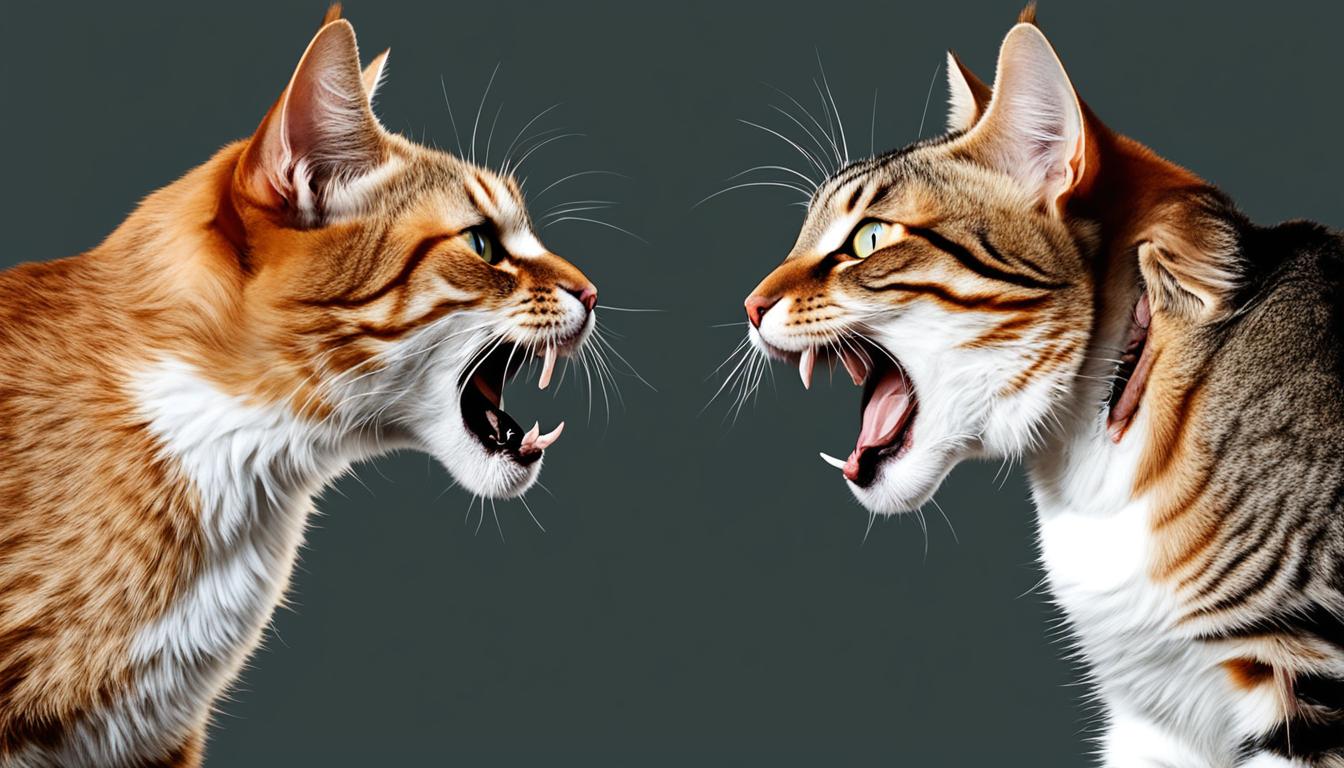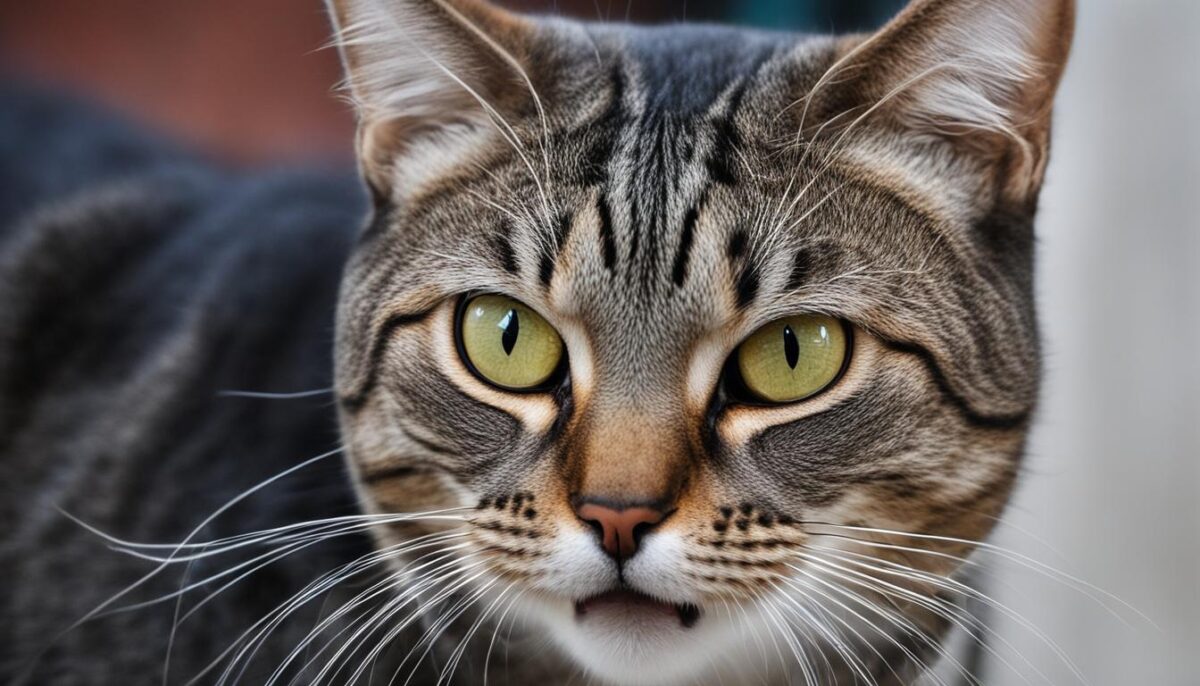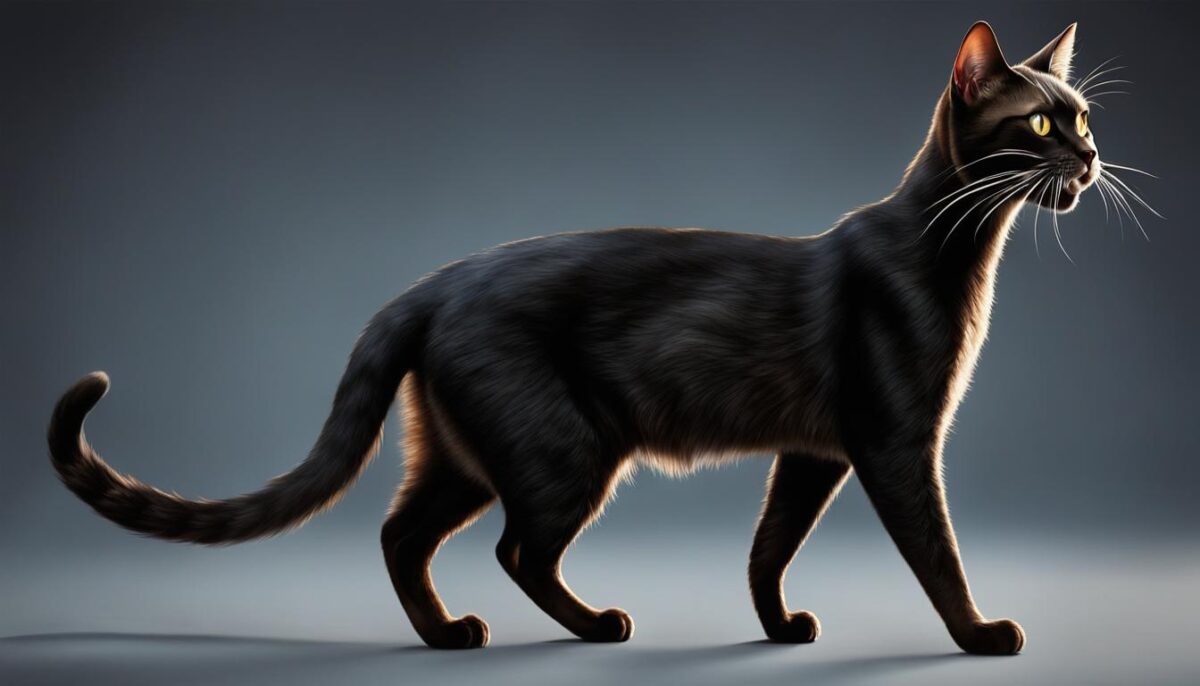Have you ever heard your cat make a deep, rumbling sound? That’s a growl! Cats growl for many reasons and it’s a big part of cat behavior. Like people, cats use sounds and movements to tell us how they feel. Maybe you’ve seen a happy cat with a straight-up tail or making itself look big – that could mean they’re in a great mood, or maybe they’re trying to say, “This is my space!”
To really get what your cat is thinking, you should look at what’s happening around them. A scared cat can curl up small, or a sick cat might not want to play. The place they’re in and what they hear and smell all matter too. So when you hear a growl, it’s like your cat is trying to say something important with their own feline communication. And by watching and listening to them, you can start understanding cats better, especially when they talk in growls.
Key Takeaways
- Cats growl to talk about how they’re feeling.
- Looking at a cat’s tail and size can help you know if they’re happy.
- A scared cat might look small, while a cat in a good mood will look big and tall.
- The place a cat is in and the things they smell and hear change how they act.
- Growling is just one of the ways cats talk to us and to each other.
The Basics of Cat Communication
Cats talk to us without words. They tell us loads of things if we pay attention. Let’s dive into how they do that with sounds and moves!
Interpreting Vocal Behaviors
Cats make different sounds, like meows, purrs, and growls. Each sound can mean something special. A meow might be a cat asking for dinner or just saying hi. A purr usually means they’re feeling good. If you hear a growl, it might mean “give me space”.
How Cats Use Body Language
Cat body posture speaks volumes. When cats are happy, their ears point up and they might make soft chirping sounds. But if they’re scared or upset, their backs arch and fur stands up. It’s their way of talking without a meow or purr.
The Context Matters
It’s not just the sounds or moves, but also the cat social cues that tell the full story. Like us, if they’re in a new place or hear loud noises, they might act differently. Always look around to see what’s affecting your furry friend.
| Sound | What It Might Mean |
|---|---|
| Meow | Wants attention or food |
| Purr | Feeling happy or relaxed |
| Growl | Scared or asking for space |
Now you know a bit more about how to see and hear what cats are saying. Next time, when you watch them, see if you can tell how they’re feeling!
Why Do Cats Growl?
Have you ever heard your cat make a growling sound? It’s a deep noise that cats make for different reasons. Growling behavior in cats is just like when people use different words to say how they feel. If your cat is growling, it is trying to tell you something.
Sometimes, the cat growling meaning is that your furry friend might be feeling scared. Other times, it could be annoyed or even mad. Cats growl to talk to each other too. It’s an important part of cat vocalizations. Let’s look at what your cat’s growl might mean.
- If your cat is growling and its ears are back, it might be saying, “I’m scared!”
- Is your cat’s hair standing up too? It might be telling another animal, “Stay away from me!”
- Sometimes, a cat growls because it is saying hello in a rough way. Yes, cats can be a bit grumpy!
It’s kind of like how you might yell, “This is my toy!” if someone grabs your favorite stuffed animal. Your cat is using a growl to say, “This is my space!”
| Growl Sound | What It Might Mean |
|---|---|
| Low and steady | Your cat is warning that it’s annoyed or might want to be left alone. |
| Quick and sharp | Something has scared your cat, and it’s telling that thing to go away. |
| Soft but rough | Your cat could be unsure or just saying a tough “hello” to you or another cat. |
Remember, your cat is not trying to be mean. It just uses growls to speak. Next time you hear your cat growl, try to listen to what it is telling you!
Signs of a Happy Cat
Can you tell when your cat is happy? It’s easy when you know what to look for! Happy cat signs are all about the way they act and look. Cats that are content love to show it! We’re talking about soft purrs, slow blinks, and even that cute little tail flick. If you see these things, you’re seeing a happy kitty!
When cats are happy, their eyes are round with tiny pupils. Their bodies feel soft, not tense. And they love to rub against you! This means they trust you and feel safe. It’s like a big, warm, furry hug. Recognizing a happy cat helps us make sure they stay that way.
- A soft, relaxed body
- Slow eye blinks – like kitty kisses!
- A tail that sticks up high with a little curl
- Purring and rubbing against your legs
Let’s make a fun game of it! Next time you play with your cat, see how many happy signs you can spot. For a bonus, give them a gentle belly rub or a tasty treat. Watching for these signs makes sure your cat stays as happy as can be!
| Happy Cat Behavior | What It Means |
|---|---|
| Soft, shiny fur | Your cat feels good and is taking care of itself. |
| Meowy talks | They’re telling you all about their day and are happy to chat! |
| Playing and jumping | Happy cats have energy and love to play. Let’s get moving! |
| Sleeping in the sun | They’re comfy and cozy, dreaming happy dreams. |
Understanding Stress and Anxiety in Cats
Have you noticed changes in your furry friend’s behavior lately? Just like us, cats can feel stressed and anxious, and it’s important for their humans to recognize the signs of stress and know how to help them feel better. Let’s learn about cat anxiety symptoms and ways for managing cat stress.
Physical Signs of Stress in Cats
Cats can’t tell us with words when they’re not feeling great, so they show us in other ways. A stressed cat might hunch close to the floor as if they want to hide. They might keep licking their lips or yawn a lot, which isn’t just them being sleepy or bored; it’s like saying, “I’m worried!” Watch out if your cat is not using the kitty litter box too—it’s another way they say, “I’m not okay!”
Environmental Causes of Cat Anxiety
Cats love having their own special hidey-holes and a calm, quiet space. When things get too noisy or someone invades their space, think of it as someone barging into your room without knocking—not cool, right? This can make your cat anxious. Even small changes at home can upset them.
| Stress Sign | What It Looks Like |
|---|---|
| Body Posture | Hiding or staying low to the ground |
| Licking | Licking lips excessively |
| Yawning | Yawning at odd times, not just when sleepy |
| Litter Box Avoidance | Avoiding using their litter box |
| Space Invasion Distress | Getting jumpy when their personal space is encroached |
| Noise Sensitivity | Getting scared by loud sounds |
So, if you spot your cat being extra clingy, hiding, or licking itself a lot, it’s time to play detective and figure out what’s bugging them. With a little patience and love, you can make your cat’s world a calm and happy place once again.
When Fear Takes Hold: Recognizing Fearful Cat Behavior
Have you ever seen a kitty look very tiny and quiet? Maybe they seemed scared. When cats feel fearful, they act in special ways. Their big eyes, flat ears, and tails wrapped tight show us they are scared cats. Cats might make a hiss or a growl when they are full of cat fear. They are not trying to be mean. They are just very, very fearful.
Where do scared kitties like to go? To places that feel safe. Just like you love a cozy blanket, kitties love a cozy spot. We can help them by giving them a safe space. It’s like saying, “Hey little buddy, you can hide here until you feel all better.”
- Fear can make a cat hide or try to run away.
- Big eyes and flat ears are signs a cat is scared.
- Tails wrapped tight around their body is also a sign they’re not feeling brave.
- Growls or hisses are like a kitty’s way of shouting because they’re surprised or scared.
If you see a kitty acting this way, be super gentle and quiet. Give them some time to see that all is okay. Once they feel safe, they’ll start to come out and be their happy, purring selves again.
Aggression in Felines and Its Indicators
Understanding aggressive cats can be as complex as solving a puzzle. If you notice cat aggression signs, it’s crucial to learn their body language interpretation. By figuring out what your cat’s posture and sounds mean, you can help keep them calm and safe.
Body Language of an Aggressive Cat
When your furry friend feels threatened and gets aggressive, it might puff up its fur, just like a fluffy pillow! They do this to look bigger and scarier to whoever is bothering them. A cat might also make a Halloween pose – arching its back high. Their ears will lay flat against their head, much like the wings of a plane. These signs mean your cat feels very upset and is trying to say, “Back off!”
Vocalizations and Growls: Signs of Aggression
Cat body language interpretation isn’t just about their looks; their sounds matter, too. An aggressive cat might growl or hiss – these are their alarm bells. If you hear these noises, think of them as a clear, “I’m not happy!” Your cat is trying hard to tell you and others to give them some room.
| Body Language | What It Means |
|---|---|
| Fur puffed up | Trying to look big and scary |
| Back arched | Defensive and feeling threatened |
| Ears flat | Upset and possibly ready to fight |
| Growling or hissing | Warning to stay away or give space |
Always remember – if your cat is acting this way, they’re feeling pretty stressed out. It’s their way of coping with a situation. Give them some quiet time and space to relax. That way, everyone stays happy and safe!
Is Your Cat in Pain? Understanding the Signs
Understanding if cats are in pain can be tricky because they are quite the experts at hiding it. But there are ways of recognizing pain in cats if you know what to look for. It’s all about the cat health signs they show us with their bodies and behavior.
One way cats might tell you they are not feeling good is by the way they sit. If they keep their legs tucked under their body more than usual, it could be a sign. Are their eyes kind of squinty? Or maybe you can see part of their third eyelid? These could be little clues that your furry friend isn’t well.
Also, listen to them. A cat that is normally quiet but starts to meow or purr a lot might be trying to tell you something. It’s their way of saying, “Hey, something’s not right here!”
| Signs Your Cat Might Be in Pain | What This Sign Means |
|---|---|
| Sits with legs tucked | Maybe sore or uncomfortable |
| Squinty eyes or visible third eyelid | Possible sign of eye pain or other discomfort |
| More meowing or purring than normal | Your cat could be seeking attention for feeling unwell |
Keep in mind, each cat is unique so they might show different signs. Always be kind and gentle with your kitty, especially if you think they’re not feeling their best. It’s important to notice these cat health signs early so you can help them feel better quicker.
Conclusion
When you hear a cat growl, it’s not just a random noise—it’s a way for your furry friend to talk to you. Growls, purrs, meows, and all the little moves your cat makes are just parts of their special language. By learning and understanding this language, you can figure out what cats are feeling. This helps make sure they’re as happy and healthy as can be. Cat growling explained means you’re getting to know your cat’s feelings better.
Remember, it’s like piecing together a puzzle. Every sound and move fits together to tell you what your cat wants or needs. By looking at everything that’s happening, you can speak cat too! It’s not just about feline behavior comprehension, it’s about becoming the best buddy a cat could have. It’s all about healthy cat communication.
So next time your cat growls, purrs, or does a little dance with its tail, take a moment to think about what they might be saying. You’re on your way to being an amazing friend to your cat, just by understanding their special cat way of talking to you.
FAQ
What are some common vocalizations cats use, and what do they mean?
Cats often communicate through vocalizations like meowing, purring, and growling. Meows can signal a request for attention or food, purrs may indicate contentment or sometimes pain, and growling could be a sign of discomfort or a warning to back off.
How does a cat’s body language help convey its mood?
A cat’s body language is very expressive — a straight-up tail can mean happiness, whereas an arched back and fluffed fur often signal fear or aggression. Pay attention to their ears, eyes, and body posture for clues on how they’re feeling.
Why is it important to consider the context when interpreting a cat’s behavior?
Just like humans, a cat’s behavior can be influenced by its environment. Noises, unfamiliar scents, or the presence of strangers can change how cats act. It’s crucial to note their surroundings to accurately understand their behavior.
What cues suggest that a cat is content and happy?
A happy cat will display a relaxed body posture, have round eyes with tiny pupils, and its tail might be upright with a slight curl at the end. Look for behaviors like slow-blinking, which can indicate they trust and are comfortable around you.
What are signs of stress or anxiety in cats?
Signs of stress in cats include stiff movements, excessive grooming, hiding, or even avoiding the litter box. Changes in their environment, such as loud noises or loss of hiding spots, can also contribute to anxiety.
How can I tell if a cat is feeling frightened?
A fearful cat might try to make itself appear small or hide. You’ll see wide-open eyes, pinned-back ears, and a tightly wrapped tail. Hissing or growling are serious signs that the cat is scared and seeking to intimidate what it perceives as a threat.
What does the body language of an aggressive cat look like?
An aggressive cat may puff up its fur, arch its back, and stare intensely. Flat ears and loud growling are also key indicators. This body language is part of their defense mechanism to avoid actual conflict if possible.
How can I recognize if my cat is in pain?
Cats are experts at hiding pain, but you can spot subtle signs like changes in posture, activity level, or appetite. They may also purr excessively or show a third eyelid. It’s essential to consult a vet if you suspect your cat is hurting.


